Plenty of YouTube videos on this but here is a simple guide to getting started. The secret, as with many things in life, is persistence!
Very simple equipment:
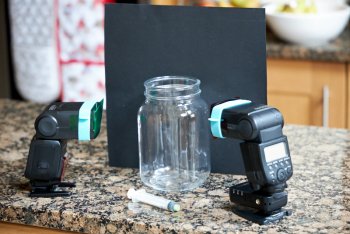
I've used two speed lights (flash guns) and equipped them with different coloured gels (red and green in this example). Wireless trigger (optical or radio). You can also do this with continuous lighting and with no gels depending on what you want to achieve but easier with flash.
A decent-sized (but not too big) transparent water container. I've used a Kilner jar here but an aquarium or even a glass flower vase would do the job. Big is better for the container (flat sides as well) but the larger the container, the more water you have to change after a couple of shots.
Black card or something like that behind the container.
Medicine dropper or syringe (here is one from an ink-jet refill kit).
Camera with a macro lens or a long focal length lens at its closest focussing distance.
Dropping liquid. You can use ink in water, water-based (vinyl) paint, milk, cream or any number of coloured or colourless liquids. Best effect is with opaque liquids (milk, cream, paint etc) to give the flash something to reflect from. Playing with the dropping liquid properties (viscosity, oiliness) has a big impact on the nature of the flow observed.
Put the camera on a tripod or solid surface and set to manual focus and use a spoon or your finger to set the camera focus point to where you want the drop to enter the liquid container. Set your camera to manual and set aperture to a reasonably high number for decent depth of field (use at least f8). Set shutter speed to around 1/150s and take a shot with no flash. Frame should be black.
Turn on flash and fill dropper/syringe with the dropping liquid.
Let one or more drops fall onto the water in the tank at the focus point you set earlier and take the photo simultaneously. By changing the time between drop impact and shutter activation, you can vary the effect you see.
Repeat until the water gets too murky then clean and refill the tank and start again.
Post processing. If you get the exposure right in camera then not much to do. Crop to suit, darken the blacks a bit and boost the highlights to your taste. Sometimes works well to rotate the image to make it look like the flow is coming from the side or the bottom of the screen.
Straight from the camera:
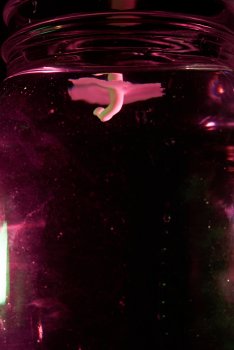
Crop, rotate and darken blacks:
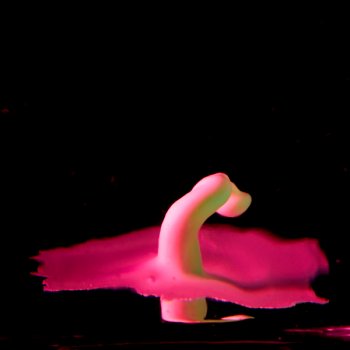
here, you can see the effect of using two coloured flashes (red & green) on a cream-based fluid with very short delay between drop and photo.
Different drop liquids give different dispersion properties. Here is an example of diluted vinyl paint (green) again with red and green flash gels:
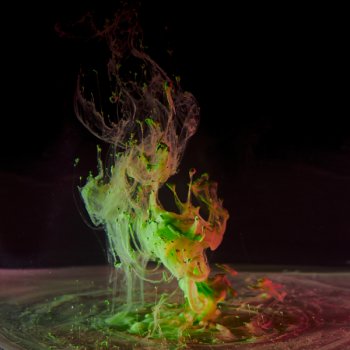
You can also be more imaginative in post eg mirror image technique:
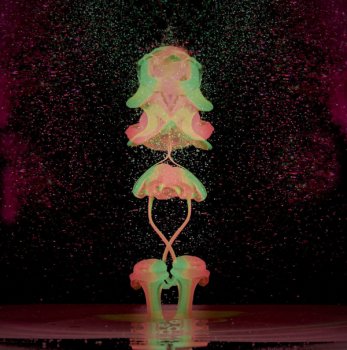
This one also had glittery-bits mixed into the dropping fluid.
Go forth and play!
Very simple equipment:

I've used two speed lights (flash guns) and equipped them with different coloured gels (red and green in this example). Wireless trigger (optical or radio). You can also do this with continuous lighting and with no gels depending on what you want to achieve but easier with flash.
A decent-sized (but not too big) transparent water container. I've used a Kilner jar here but an aquarium or even a glass flower vase would do the job. Big is better for the container (flat sides as well) but the larger the container, the more water you have to change after a couple of shots.
Black card or something like that behind the container.
Medicine dropper or syringe (here is one from an ink-jet refill kit).
Camera with a macro lens or a long focal length lens at its closest focussing distance.
Dropping liquid. You can use ink in water, water-based (vinyl) paint, milk, cream or any number of coloured or colourless liquids. Best effect is with opaque liquids (milk, cream, paint etc) to give the flash something to reflect from. Playing with the dropping liquid properties (viscosity, oiliness) has a big impact on the nature of the flow observed.
Put the camera on a tripod or solid surface and set to manual focus and use a spoon or your finger to set the camera focus point to where you want the drop to enter the liquid container. Set your camera to manual and set aperture to a reasonably high number for decent depth of field (use at least f8). Set shutter speed to around 1/150s and take a shot with no flash. Frame should be black.
Turn on flash and fill dropper/syringe with the dropping liquid.
Let one or more drops fall onto the water in the tank at the focus point you set earlier and take the photo simultaneously. By changing the time between drop impact and shutter activation, you can vary the effect you see.
Repeat until the water gets too murky then clean and refill the tank and start again.
Post processing. If you get the exposure right in camera then not much to do. Crop to suit, darken the blacks a bit and boost the highlights to your taste. Sometimes works well to rotate the image to make it look like the flow is coming from the side or the bottom of the screen.
Straight from the camera:

Crop, rotate and darken blacks:

here, you can see the effect of using two coloured flashes (red & green) on a cream-based fluid with very short delay between drop and photo.
Different drop liquids give different dispersion properties. Here is an example of diluted vinyl paint (green) again with red and green flash gels:

You can also be more imaginative in post eg mirror image technique:

This one also had glittery-bits mixed into the dropping fluid.
Go forth and play!

